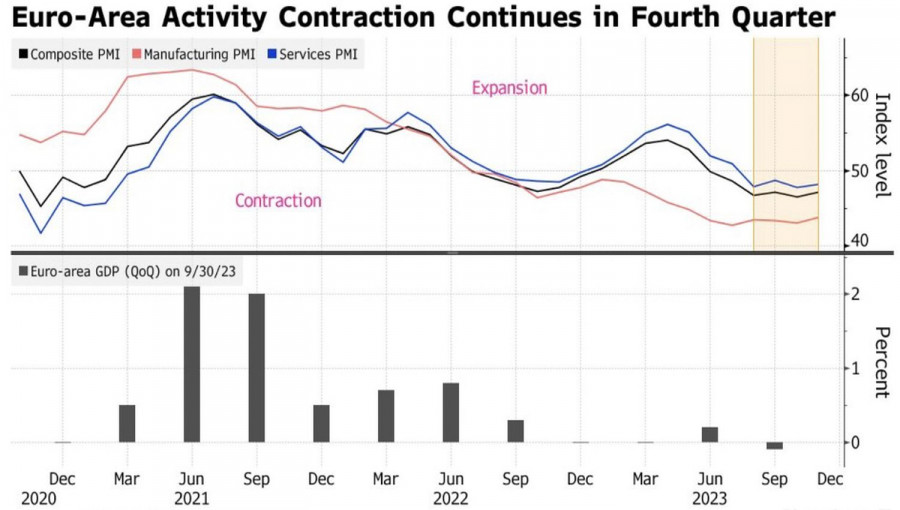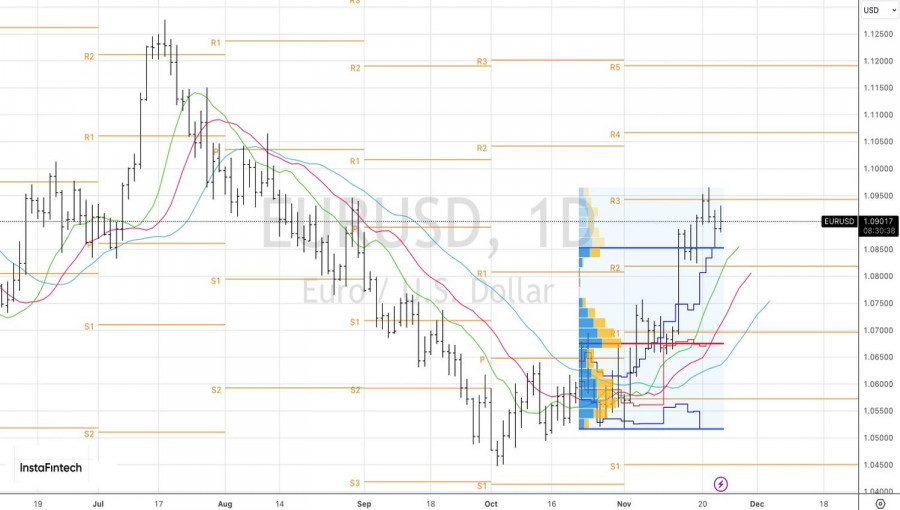
It's challenging to be optimistic about the currency of a region whose economy is mired in difficulties. Despite the fact that the Eurozone's composite Purchasing Managers' Index (PMI) in November exceeded Bloomberg experts' forecasts, it has been below the critical 50-mark for the sixth consecutive month, indicating a contraction in GDP. It seems that the currency bloc has plunged into a recession rather than slowly emerging from the pit, as forecasted by the European Commission. This is particularly unfavorable for EUR/USD.
European Central Bank Vice President Luis de Guindos had valid reasons to warn markets about underestimating the impact of monetary restraint on the economy. Investors were overly optimistic, expecting a soft landing. In reality, stagnation continues, and the divergence in GDP growth between the Eurozone and the USA supports the bears on EUR/USD.
Business Activity Dynamics and Eurozone GDP

The minutes of the latest Governing Council meeting note the effective transmission of monetary policy tightening to the currency bloc's economy. However, the consequences of the 450 basis point deposit rate hike have not been fully accounted for yet.
Nevertheless, the ECB is ready to resume the cycle of monetary restraint if necessary, contingent on new data. While such a scenario is not the baseline, it seems that markets are truly getting ahead of themselves, anticipating a sharp rise in borrowing costs by 100 basis points in 2024. The European Central Bank has left the door open for a rate hike, and its officials have criticized the markets for their pricing multiple times.
Unexpectedly, the victory of the far-right Freedom Party in the parliamentary elections in the Netherlands is putting pressure on the euro. Its leader promised a referendum on the country's exit from the EU. However, in the recent history of the Netherlands, only once did the leader of the winning party not become the prime minister. If this does not happen for the second time, anti-European sentiments will pull EUR/USD down.
Despite the negatives from the economy and politics, the euro clings to the crucial $1.09 level due to the unfavorable external backdrop for the US dollar. On Thanksgiving Day, American markets are closed, but the ongoing rally in stock indices and the decline in Treasury bond yields force the USD index to go down. Currency competitors benefit from dollar's weakness yesterday, and the euro is no exception.

Investors' risk appetite may have awakened prematurely. It is difficult to count on a federal funds rate cut in May if the U.S. economy stands firmly, the labor market is strong, and the risks of new inflationary pressures have not disappeared. The EUR/USD rally has gone too far, and consolidation seems to be the most likely scenario.
Technically, the formation of a bar with a long lower shadow indicates weakness among EUR/USD sellers. However, their opponents failed to capitalize on this, unable to storm the resistance at 1.092. In such a situation, we sell the euro on the rise to $1.094 and $1.098 and buy on the decline with a rebound from $1.085 and $1.081.